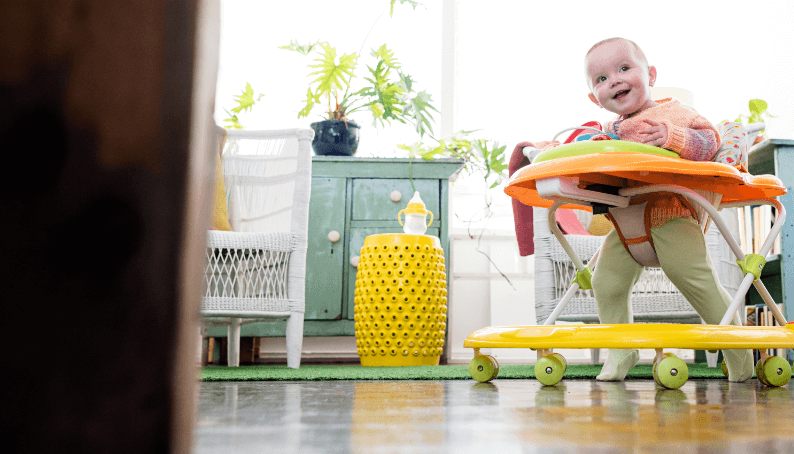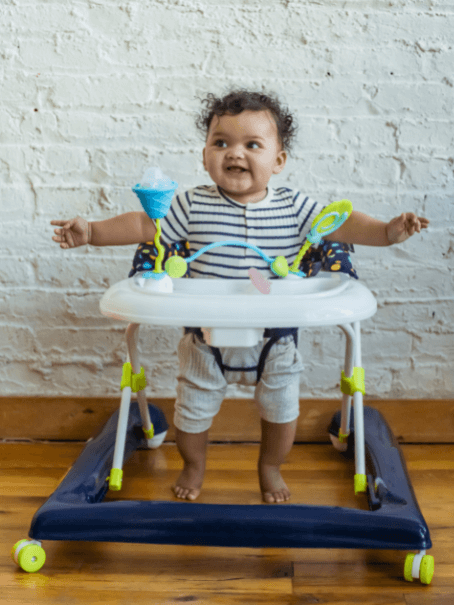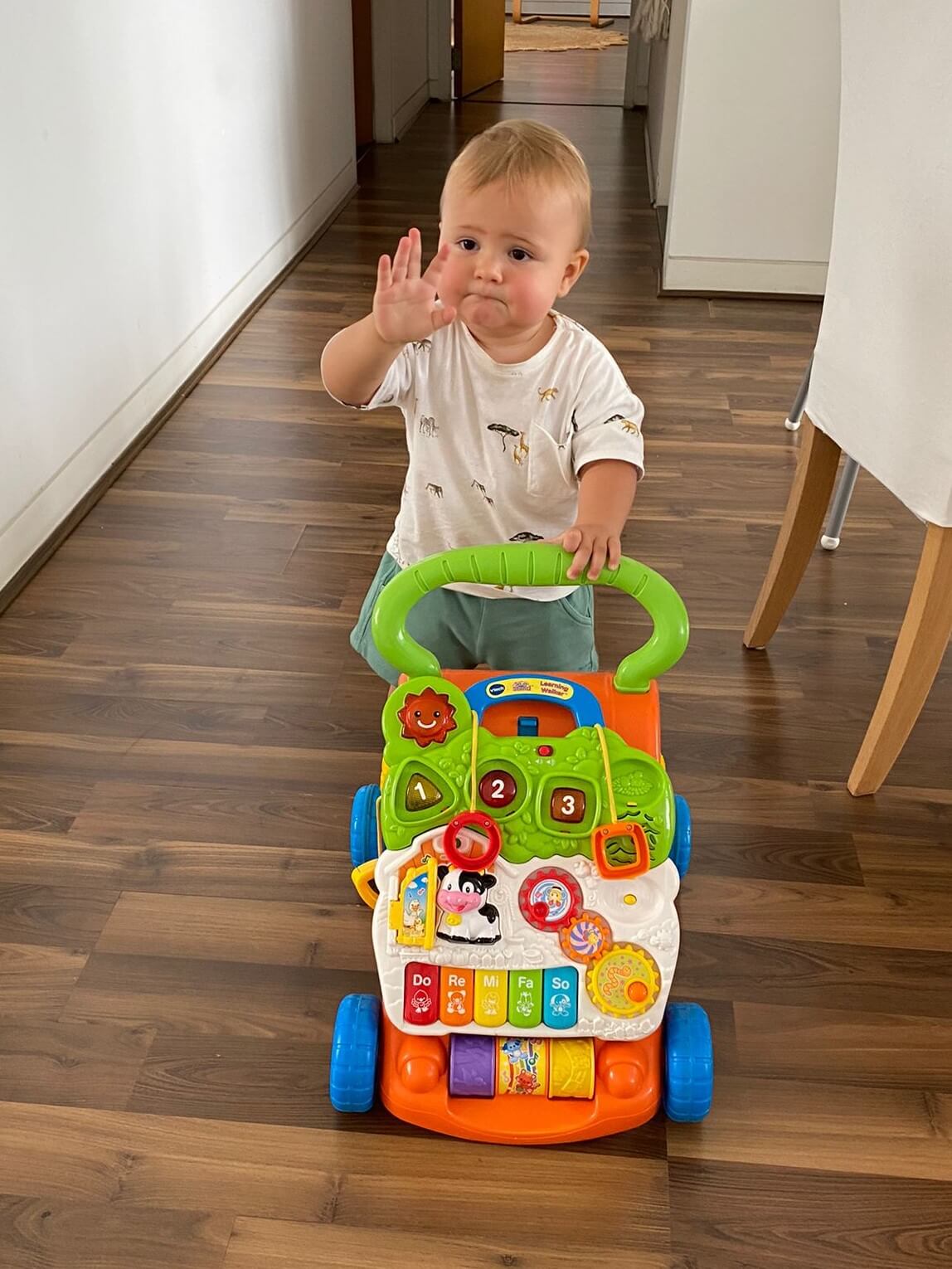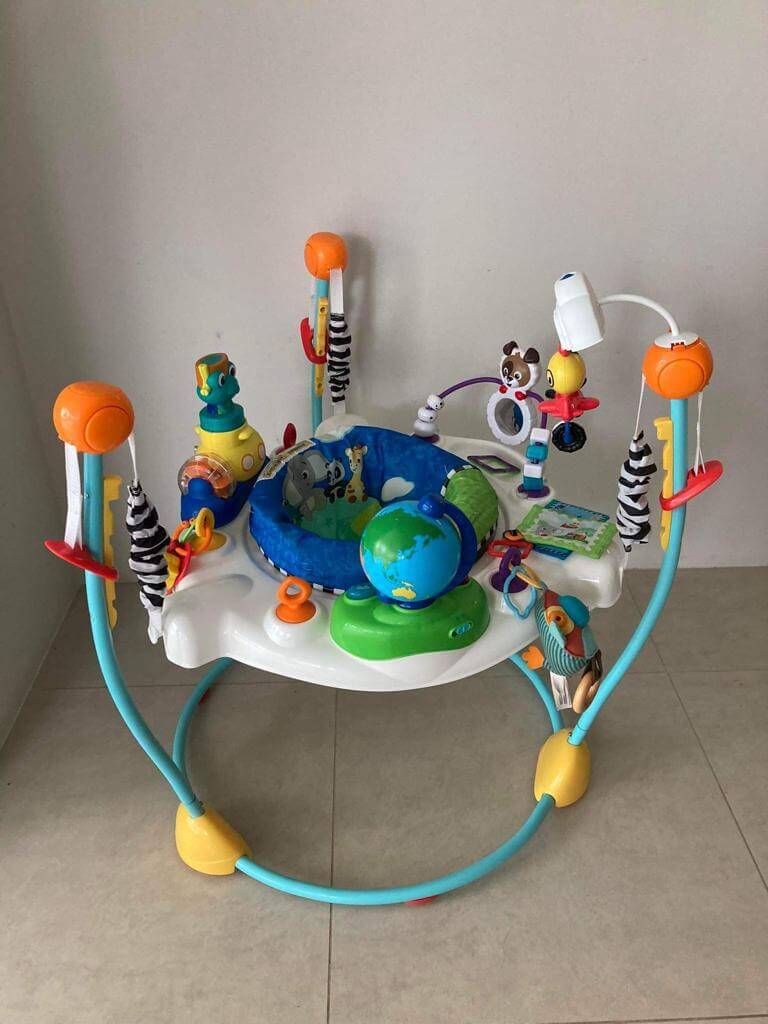What’s The Big Deal About Baby Walkers?

By Sarah Russell
Around the world, 50–70% of 3 to 12-month-old babies use a baby walker (1). While they might be fun and entertaining for some babies, give parents some hands-free time, and current research doesn’t clearly indicate that baby walkers impact child development, these wheeled devices are banned in Canada and aren’t recommended by the American Association of Pediatrics due to safety concerns (2). Confused yet?
Are baby walkers safe?
All baby equipment comes with some risks and warnings. Studies show that as few as 12% to as many as 50% of babies experience an accident or an injury using a baby walker (3). In fact, between 1990 and 2014, 230,000 children aged 15 months and younger in the US ended up in the emergency room after being injured while using a walker (4). Despite the known risks however, 89% of pediatricians in the UK argue that there isn't enough evidence to influence parents’ decision-making regarding baby walkers (5).
Will using a baby walker help my baby learn to walk?
Just as there is no clear evidence to show that baby walkers negatively impact walking development, there is also currently no evidence that baby walkers are beneficial for the development of walking (6). There is a possibility that assisting a baby to walk before they are developmentally ready may interfere with the natural development of walking, (7) but this requires further research.
Will a baby walker support my baby’s overall motor development?
Quite simply, research is inconclusive. One of the largest studies on this topic with a sample size of 190 babies noted a delay in crawling, standing alone, and walking alone in babies using a baby walker (8). Similarly, another study with a sample size of 109 babies reported that those who used a walker demonstrated motor delays in the areas of sitting, crawling, and walking, noted during a developmental assessment (9). In contrast, a study completed in 2015, albeit a smaller one with 20 babies, found no difference in motor development between babies who were and were not using a baby walker (10).


Will a baby walker impact the development of my baby’s hips and legs?
While there may be anecdotal evidence from online articles, there’s a lack of evidence-based research indicating any link between baby walkers and an impact on babies’ hip and lower limb development. Research focused on the possible impacts of baby walkers on quality of movement and other noteworthy effects such as whether they affect the development of babies’ hips, ankles, and feet is warranted.
Should I never place my baby in a baby walker?
Inconclusive and conflicting evidence makes this a challenging decision. While there does not currently appear to be enough quality research to suggest baby walkers impact the development of walking, what the research does all have in common is the recommendation that baby walkers should be used with caution until more conclusive information is available.
The bottom line? Babies will start to walk when they are ready (usually between 10 and 18 months). While it’s impossible to pinpoint what exactly supports your baby to get up and start taking those first steps, what is known is that walking is the development of many ‘mini milestones’ (such as crawling, walking with support along furniture, being able to get from sitting to standing and standing to sitting). The most important things we can provide babies with are variety and opportunities to learn, develop, and explore their bodies and their surroundings.
How can I minimize the risks of using a baby walker?
If you want to use a baby walker, understand that there are safety concerns. This applies to any equipment used with babies (e.g., bouncer, baby lounger, floor seat). If you decide to use one:
- Ensure that your baby is closely supervised at all times.
- Ensure the walker is low enough so that your baby can place both feet completely flat on the floor.
- Limit the time your child uses a walker, ensuring they also have the opportunity to practice standing, cruising, and walking around on their own, in their own time.
- Another option is an ‘exersaucer’ (see figure 3), which is similar to a baby walker but without wheels, which can make for a safer alternative. The above safety advice still applies.

What do you recommend as a children’s occupational therapist?
If you want to use a walker, I recommend a push-style baby walker (see figure 2). Push-style walkers don’t pose as many safety issues should your baby have a tumble. Additionally, they are easier to maneuver based on size and weight. Based on my own independent research, I recommend looking at the brand V-Tech, which makes a range of push walkers and is readily available in Thailand.
What else can I do to help my baby learn to walk?
- Support your baby to walk holding your hands.
- Encourage your baby to walk along furniture and objects (known as cruising) until they are ready to move away and try to take a step. You can do this by placing toys on furniture like the couch, coffee table, and on top of chairs.
- Continue to provide opportunities to strengthen and support the development of the muscles in the legs, bottom, and core through lots of play involving sitting to standing and standing to sitting, high and low kneeling, and sitting in a variety of positions (side sitting, legs out in front).
Remember to enjoy your baby at their current phase and stage. It’s tempting to want them to run before they can walk, but they are little for such a short period of time. Go enjoy your baby!
Disclaimer: At the time of writing, this was the best known information made available to the writer following a literature review. For any specific concerns regarding your baby, please contact a pediatric occupational or physical therapist.
References
- Badihian, Sh., Adihian, N., Yaghini, O. (2017) The Effect of Baby Walker on Child Development: A Systematic Review. Iranian Journal of Child Neurology. 11(4):1-6. ncbi.nlm.nih.gov/pmc/articles/PMC5703622/
- See ref. 1
- See ref. 1
- Physio Mommy (2022) Are Baby Walkers Really Harmful? physiomommy.com/are-baby-walkers-really-harmful/
- Chagas, PS., et al. (2011) Beliefs about the use of baby walkers. Revista Brasileira Fisioterapia. 15(4):303-9. researchgate.net/publication/51604980_Beliefs_about_the_use_of_baby_walkers
- See ref. 1
- Siegel, AC., Burton, RV. (1999) Effects of baby walkers on motor and mental development in human infants. Journal of Developmental and Behavioral Pediatrics. 20(5):355-61. pubmed.ncbi.nlm.nih.gov/10533994/
- Garrett, M., McElroy, A., Staines, A. (2002) Locomotor milestones and babywalkers: Cross sectional study. British Medical Journal Clinical Research. 2002; 324(7352):1494. researchgate.net/publication/11298067_Locomotor_milestones_and_babywalkers_Cross_sectional_study
- See note 7
- Schopf, PP., Santos, CC. (2015) The influence of baby walker usage in the sensory motor development of children at schools in early childhood education. Journal of Human Growth Development. 25(2):156-161. revistas.usp.br/jhgd/article/view/102998
About the Author
Sarah Russell is an Australian-trained pediatric occupational therapist. Since 2014, she has been working in South East Asia, formerly in an international school and private practice, until becoming a mum herself. Sarah is particularly interested in empowering babies to move, grow, and thrive through simple, yet fun and interactive play. To contact Sarah, please email: stamburrini@gmail.com.
